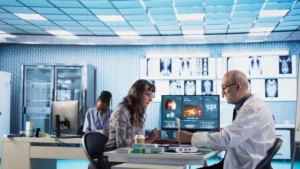Table of Contents
Key Takeaways:
- The MRD is the central hub for managing patient health information meticulously and confidentially.
- It supports clinical care, legal compliance, hospital administration, and research through accurate documentation.
- Digital transformation in MRD enhances efficiency, security, and interoperability in hospitals.
- Career opportunities in MRD are growing in healthcare, IT, and insurance sectors, backed by specialized courses.
- Effective MRD management drives better patient outcomes, reduces errors, and optimizes hospital operations.
Introduction: What Is the MRD Department in a Hospital?
The Medical Records Department (MRD) is the heart of a hospital’s information system, tasked with managing, organizing, and safeguarding all patient medical records. It ensures that every detail—from diagnosis and treatment to lab reports and discharge summaries—is systematically documented, stored, and made available when needed. The MRD’s work is foundational to patient care, hospital administration, and regulatory compliance.
In an age where data drives healthcare decisions, the MRD is more than just a record-keeping unit. It’s a dynamic department that supports clinical staff, hospital management, insurance providers, and even legal authorities with reliable, up-to-date patient information. Every hospital, big or small, relies on the MRD to maintain the integrity and confidentiality of its patient records.
Also read: Types of Medical Records
What Are the Objectives of the MRD Department?
1: What is the primary role of a hospital administrator?
The MRD’s primary objectives are to:-
- Maintain accurate, complete, and timely medical records for every patient.
- Facilitate quick and secure access to records for healthcare providers and authorized personnel.
- Ensure patient confidentiality and data privacy in line with legal and ethical standards.
- Support hospital administration, research, and quality assurance through data analytics and reporting.
- Aid in medico-legal documentation, insurance claims, and compliance with healthcare regulations.
Hospital Administration Course with Assured Career Growth
Hospital Administration Course by Entri App: Master essential healthcare management skills, gain certification, and secure top roles in leading hospitals
Join Now!How Is the MRD Department Structured?
The MRD is organized in a clear hierarchy to ensure efficiency and accountability. Below is a typical organizational structure for the MRD in a hospital:
| Position/Role | Key Responsibilities |
|---|---|
| Head of MRD (Chief Medical Record Officer) | Oversees all MRD operations, ensures compliance, and manages staff. |
| Medical Record Officer | Supervises record processing, coding, and daily operations. |
| Medical Record Technician | Handles data entry, coding, and record maintenance. |
| Record Clerk/Data Entry Operator | Manages physical and digital filing, record retrieval, and basic data processing. |
| IT Support/HIS Administrator | Maintains electronic medical record (EMR) systems and ensures data security. |
What Are the Major Functions of the MRD Department?
The MRD department is responsible for a wide range of activities that ensure the smooth functioning of hospital record management. These functions are critical for maintaining accurate, accessible, and secure patient data:
- Outpatient and Inpatient Record Management: The MRD collects, processes, and maintains medical records for both outpatient and inpatient cases. This includes registering new patients, updating revisit records, and ensuring all clinical information is complete and up to date.
- Record Storage and Retrieval: All patient records are systematically stored, whether physically or digitally. The MRD ensures that records can be retrieved quickly and securely whenever needed by doctors, nurses, or other authorized staff.
- Coding and Indexing: Medical records are coded using standardized systems (like ICD-10) for diagnoses and procedures. This enables efficient data analysis, billing, and research, and ensures records are easy to locate and interpret.
- Statistical Reporting: The MRD prepares regular reports on hospital statistics, including patient admissions, discharges, diagnoses, and outcomes. These reports help hospital management with planning, policy-making, and regulatory compliance.
- Medico-Legal Documentation: The department issues medico-legal certificates, manages records for legal cases, and ensures compliance with statutory requirements, such as birth and death notifications.
- Data Confidentiality and Security: The MRD implements strict protocols to protect patient privacy, ensuring that only authorized personnel can access sensitive information. This is crucial for maintaining trust and complying with healthcare regulations.
- Support for Research and Education: Medical records are used for clinical research, audits, and educational purposes. The MRD facilitates access to anonymized data for approved studies and training programs.
How Does the MRD Support Hospital Administration?
MRD plays a crucial role in hospital administration by:- Providing timely, accurate data for clinical decision-making and audits.- Ensuring compliance with accreditation standards like NABH through meticulous documentation.- Assisting in insurance claims, medico-legal cases, and government reporting.- Supporting research and policy development with reliable data analytics.
Hospital Administration Course with Assured Career Growth
Hospital Administration Course by Entri App: Master essential healthcare management skills, gain certification, and secure top roles in leading hospitals
Join Now!What Is the Role of Digital Transformation in the MRD?
The shift from paper-based to Electronic Medical Records (EMR) has revolutionized MRD operations:-
- Speed and Efficiency: EMR systems allow instant access to patient records, reducing delays in care.
- Accuracy: Automated data entry and coding minimize human errors.
- Security: Advanced encryption and access controls protect sensitive information.
- Interoperability: Digital systems enable seamless data sharing across departments and healthcare networks.
What Are the Roles and Responsibilities in the MRD?
The MRD relies on a team of professionals, each with specific roles and responsibilities:
- Head of MRD (Chief Medical Record Officer): Oversees all departmental activities, ensures compliance with policies, and manages staff. This role involves strategic planning, quality assurance, and coordination with other hospital departments.
- Medical Record Officer: Supervises daily operations, including record processing, coding, and staff training. They ensure that all records are accurate, complete, and up to date.
- Medical Record Technician: Handles data entry, coding, and maintenance of records. They are responsible for organizing and filing both physical and digital records, and for updating codes as needed.
- Record Clerk/Data Entry Operator: Manages the physical and digital filing of records, retrieves files as requested, and performs basic data processing tasks. They ensure that records are stored securely and can be accessed quickly.
- IT Support/HIS Administrator: Maintains electronic medical record (EMR) systems, ensures data security, and provides technical support to staff. They play a key role in the digital transformation of the MRD.
You might also like: Duties and Responsibilities of a Medical Records Manager
Who Can Build a Career in MRD and What Is the Scope?
Medical records management offers diverse career opportunities:-
- Educational Qualifications: Diplomas or degrees in Medical Record Technology, Health Information Management, or related fields.
- Job Roles: Technician, Coder, Compliance Officer, Health Information Manager, and more.
- Employers: Hospitals, clinics, insurance companies, research institutes, and IT firms specializing in healthcare data.
- Salary Range: ₹2,00,000 to ₹5,00,000 annually, with growth potential based on experience and qualifications.
What Challenges Does the MRD Face?
- Data Privacy: Ensuring patient confidentiality in an era of digital data breaches.
- Volume Management: Handling large volumes of both physical and digital records efficiently.
- Coordination: Facilitating smooth communication between clinical and administrative teams.
- Regulatory Compliance: Keeping up with evolving healthcare laws and technological advancements.
Why Is MRD Important to Patients and Hospitals?
The MRD is essential for both patient care and hospital administration:
- Patient Care: Accurate and complete medical records ensure that healthcare providers have all the necessary information for diagnosis and treatment. This leads to better clinical outcomes, reduces errors, and improves continuity of care.
- Hospital Efficiency: The MRD supports hospital administration by providing timely data for planning, quality assurance, and regulatory compliance. Efficient record management helps hospitals run smoothly and meet accreditation standards.
- Legal Protection: Medical records serve as legal documents in medico-legal cases, insurance claims, and audits. The MRD ensures that records are accurate, complete, and securely stored, protecting both patients and the hospital.
- Research and Policy Development: Medical records are a valuable resource for clinical research and the development of public health policy. The MRD facilitates access to anonymized data for approved studies, contributing to advancements in healthcare.
- Patient Confidentiality: The MRD implements strict protocols to protect patient privacy, ensuring that sensitive information is only accessible to authorized personnel. This builds trust and complies with healthcare regulations.
Entri’s Hospital Administration Course: Mastering MRD and Beyond
Entri’s Hospital Administration course offers comprehensive training to master the functioning and management of vital hospital departments like MRD. This course equips students with knowledge of medical records management, healthcare laws, digital health systems, and quality standards crucial for running modern hospitals efficiently.
Key features include:-
- Detailed modules on MRD roles, processes, and technology integration.
- Hands-on learning about hospital information systems and data management.
- Placement assistance with reputed healthcare organizations in Kerala.
- Focused career guidance to enter healthcare administration and medical record management.
Conclusion
The Medical Records Department is a cornerstone of modern healthcare, ensuring that patient information is managed with precision, confidentiality, and efficiency. Its role extends far beyond record-keeping—it’s integral to clinical outcomes, hospital administration, and legal compliance. As healthcare continues to embrace digital transformation, mastering MRD processes is essential for anyone aspiring to excel in hospital management and patient-centered care.
Hospital Administration Course with Assured Career Growth
Hospital Administration Course by Entri App: Master essential healthcare management skills, gain certification, and secure top roles in leading hospitals
Join Now!Frequently Asked Questions
What does the MRD department do?
It manages and maintains patient medical records, ensuring their accuracy, confidentiality, and availability to healthcare providers.
How does MRD maintain patient confidentiality?
Through strict access controls, policies, and secure digital systems compliant with data protection laws.
What qualifications are needed to work in MRD?
Typically, diplomas or degrees in Medical Record Technology, Health Information Management, or related fields.
What is the difference between MRD and EMR?
MRD is the department managing medical records, while EMR refers to electronic medical record systems used within MRD.
How does MRD impact patient care?
It ensures accurate, timely patient information is available, improving diagnosis, treatment, and continuity of care.















